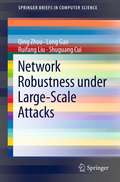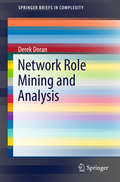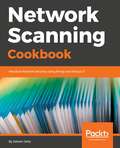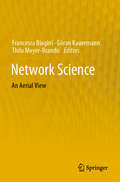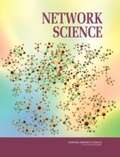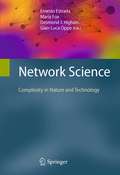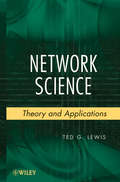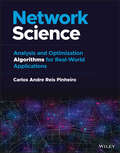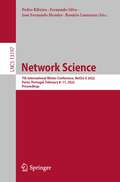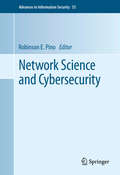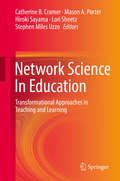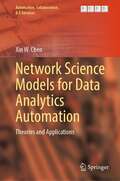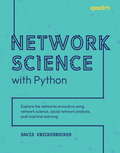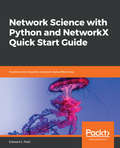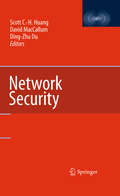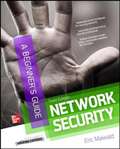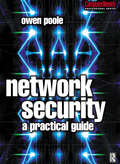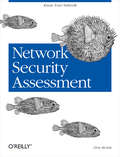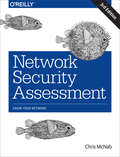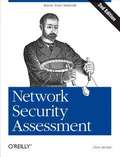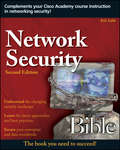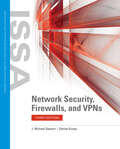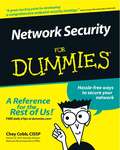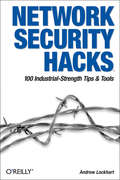- Table View
- List View
Network Robustness under Large-Scale Attacks
by Ruifang Liu Shuguang Cui Qing Zhou Long GaoNetwork Robustness under Large-Scale Attacks provides the analysis of network robustness under attacks, with a focus on large-scale correlated physical attacks. The book begins with a thorough overview of the latest research and techniques to analyze the network responses to different types of attacks over various network topologies and connection models. It then introduces a new large-scale physical attack model coined as area attack, under which a new network robustness measure is introduced and applied to study the network responses. With this book, readers will learn the necessary tools to evaluate how a complex network responds to random and possibly correlated attacks.
Network Role Mining and Analysis
by Derek DoranThis brief presents readers with a summary of classic, modern, and state-of-the-art methods for discovering the roles of entities in networks (including social networks) that range from small to large-scale. It classifies methods by their mathematical underpinning, whether they are driven by implications about entity behaviors in system, or if they are purely data driven. The brief also discusses when and how each method should be applied, and discusses some outstanding challenges toward the development of future role mining methods of each type.
Network Scanning Cookbook: Practical network security using Nmap and Nessus 7
by Sairam JettyDiscover network vulnerabilities and threats to design effective network security strategiesKey FeaturesPlunge into scanning techniques using the most popular toolsEffective vulnerability assessment techniques to safeguard network infrastructureExplore the Nmap Scripting Engine (NSE) and the features used for port and vulnerability scanningBook DescriptionNetwork scanning is a discipline of network security that identifies active hosts on networks and determining whether there are any vulnerabilities that could be exploited. Nessus and Nmap are among the top tools that enable you to scan your network for vulnerabilities and open ports, which can be used as back doors into a network.Network Scanning Cookbook contains recipes for configuring these tools in your infrastructure that get you started with scanning ports, services, and devices in your network. As you progress through the chapters, you will learn how to carry out various key scanning tasks, such as firewall detection, OS detection, and access management, and will look at problems related to vulnerability scanning and exploitation in the network. The book also contains recipes for assessing remote services and the security risks that they bring to a network infrastructure.By the end of the book, you will be familiar with industry-grade tools for network scanning, and techniques for vulnerability scanning and network protection.What you will learnInstall and configure Nmap and Nessus in your network infrastructurePerform host discovery to identify network devicesExplore best practices for vulnerability scanning and risk assessmentUnderstand network enumeration with Nessus and NmapCarry out configuration audit using Nessus for various platformsWrite custom Nessus and Nmap scripts on your ownWho this book is forIf you’re a network engineer or information security professional wanting to protect your networks and perform advanced scanning and remediation for your network infrastructure, this book is for you.
Network Science: An Aerial View
by Francesca Biagini Göran Kauermann Thilo Meyer-BrandisThis book provides an overview of network science from the perspective of diverse academic fields, offering insights into the various research areas within network science. The authoritative contributions on statistical network analysis, mathematical network science, genetic networks, Bayesian networks, network visualisation, and systemic risk in networks explore the main questions in the respective fields: What has been achieved to date? What are the research challenges and obstacles? What are the possible interconnections with other fields? And how can cross-fertilization between these fields be promoted? Network science comprises numerous scientific disciplines, including computer science, economics, mathematics, statistics, social sciences, bioinformatics, and medicine, among many others. These diverse research areas require and use different data-analytic and numerical methods as well as different theoretical approaches. Nevertheless, they all examine and describe interdependencies, associations, and relationships of entities in different kinds of networks. The book is intended for researchers as well as interested readers working in network science who want to learn more about the field – beyond their own research or work niche. Presenting network science from different perspectives without going into too much technical detail, it allows readers to gain an overview without having to be a specialist in any or all of these disciplines.
Network Science
by Committee on Network Science for Future Army ApplicationsThe U.S. Army depends on a broad array of interacting physical, informational, cognitive, and social networks. Nevertheless, fundamental understanding about these networks is primitive. This gap between what is known and what is needed to ensure the smooth operation of complex networks makes the Army’s transformation to a force capable of network-centric operations (NCO) problematic. To help address this problem, the Army asked the National Research Council to find out whether identifying and funding “network science” research could help close this gap. This book presents an assessment of the importance and content of network science as it exists today. The book also provides an analysis of how the Army might advance the transformation to NCO operations by supporting fundamental research on networks. The study finds that networks are indispensable to the defense of the United States. In addition, there is no science today that offers the fundamental knowledge necessary to design large, complex networks in a predictable manner. The study also concluded that current federal funding of network research is focused on specific applications and not on advancing fundamental knowledge.
Network Science
by Desmond J. Higham Gian-Luca Oppo Ernesto Estrada Maria FoxNetwork Science is the emerging field concerned with the study of large, realistic networks. This interdisciplinary endeavor, focusing on the patterns of interactions that arise between individual components of natural and engineered systems, has been applied to data sets from activities as diverse as high-throughput biological experiments, online trading information, smart-meter utility supplies, and pervasive telecommunications and surveillance technologies. This unique text/reference provides a fascinating insight into the state of the art in network science, highlighting the commonality across very different areas of application and the ways in which each area can be advanced by injecting ideas and techniques from another. The book includes contributions from an international selection of experts, providing viewpoints from a broad range of disciplines. It emphasizes networks that arise in nature--such as food webs, protein interactions, gene expression, and neural connections--and in technology--such as finance, airline transport, urban development and global trade. Topics and Features: begins with a clear overview chapter to introduce this interdisciplinary field; discusses the classic network science of fixed connectivity structures, including empirical studies, mathematical models and computational algorithms; examines time-dependent processes that take place over networks, covering topics such as synchronisation, and message passing algorithms; investigates time-evolving networks, such as the World Wide Web and shifts in topological properties (connectivity, spectrum, percolation); explores applications of complex networks in the physical and engineering sciences, looking ahead to new developments in the field. Researchers and professionals from disciplines as varied as computer science, mathematics, engineering, physics, chemistry, biology, ecology, neuroscience, epidemiology, and the social sciences will all benefit from this topical and broad overview of current activities and grand challenges in the unfolding field of network science.
Network Science
by Ted G. LewisA comprehensive look at the emerging science of networksNetwork science helps you design faster, more resilient communication networks; revise infrastructure systems such as electrical power grids, telecommunications networks, and airline routes; model market dynamics; understand synchronization in biological systems; and analyze social interactions among people.This is the first book to take a comprehensive look at this emerging science. It examines the various kinds of networks (regular, random, small-world, influence, scale-free, and social) and applies network processes and behaviors to emergence, epidemics, synchrony, and risk. The book's uniqueness lies in its integration of concepts across computer science, biology, physics, social network analysis, economics, and marketing.The book is divided into easy-to-understand topical chapters and the presentation is augmented with clear illustrations, problems and answers, examples, applications, tutorials, and a discussion of related Java software. Chapters cover:OriginsGraphsRegular NetworksRandom NetworksSmall-World NetworksScale-Free NetworksEmergenceEpidemicsSynchronyInfluence NetworksVulnerabilityNet GainBiologyThis book offers a new understanding and interpretation of the field of network science. It is an indispensable resource for researchers, professionals, and technicians in engineering, computing, and biology. It also serves as a valuable textbook for advanced undergraduate and graduate courses in related fields of study.
Network Science: Analysis and Optimization Algorithms for Real-World Applications
by Carlos Andre PinheiroNetwork Science Network Science offers comprehensive insight on network analysis and network optimization algorithms, with simple step-by-step guides and examples throughout, and a thorough introduction and history of network science, explaining the key concepts and the type of data needed for network analysis, ensuring a smooth learning experience for readers. It also includes a detailed introduction to multiple network optimization algorithms, including linear assignment, network flow and routing problems. The text is comprised of five chapters, focusing on subgraphs, network analysis, network optimization, and includes a list of case studies, those of which include influence factors in telecommunications, fraud detection in taxpayers, identifying the viral effect in purchasing, finding optimal routes considering public transportation systems, among many others. This insightful book shows how to apply algorithms to solve complex problems in real-life scenarios and shows the math behind these algorithms, enabling readers to learn how to develop them and scrutinize the results. Written by a highly qualified author with significant experience in the field, Network Science also includes information on: Sub-networks, covering connected components, bi-connected components, community detection, k-core decomposition, reach network, projection, nodes similarity and pattern matching Network centrality measures, covering degree, influence, clustering coefficient, closeness, betweenness, eigenvector, PageRank, hub and authority Network optimization, covering clique, cycle, linear assignment, minimum-cost network flow, maximum network flow problem, minimum cut, minimum spanning tree, path, shortest path, transitive closure, traveling salesman problem, vehicle routing problem and topological sort With in-depth and authoritative coverage of the subject and many case studies to convey concepts clearly, Network Science is a helpful training resource for professional and industry workers in, telecommunications, insurance, retail, banking, healthcare, public sector, among others, plus as a supplementary reading for an introductory Network Science course for undergraduate students.
Network Science: 7th International Winter Conference, NetSci-X 2022, Porto, Portugal, February 8–11, 2022, Proceedings (Lecture Notes in Computer Science #13197)
by Pedro Ribeiro Fernando Silva José Fernando Mendes Rosário LaureanoThis book constitutes the refereed proceedings of the 7th International Conference and School of Network Science, NetSci-X 2022, held in Porto, Portugal, in February 2021. The 13 full papers were carefully reviewed and selected from 19 submissions. The papers deal with the study of network models in domains ranging from biology and physics to computer science, from financial markets to cultural integration, and from social media to infectious diseases.
Network Science and Cybersecurity
by Robinson E. PinoNetwork Science and Cybersecurity introduces new research and development efforts for cybersecurity solutions and applications taking place within various U.S. Government Departments of Defense, industry and academic laboratories. This book examines new algorithms and tools, technology platforms and reconfigurable technologies for cybersecurity systems. Anomaly-based intrusion detection systems (IDS) are explored as a key component of any general network intrusion detection service, complementing signature-based IDS components by attempting to identify novel attacks. These attacks may not yet be known or have well-developed signatures. Methods are also suggested to simplify the construction of metrics in such a manner that they retain their ability to effectively cluster data, while simultaneously easing human interpretation of outliers. This is a professional book for practitioners or government employees working in cybersecurity, and can also be used as a reference. Advanced-level students in computer science or electrical engineering studying security will also find this book useful .
Network Science In Education: Transformational Approaches in Teaching and Learning
by Catherine B. Cramer Mason A. Porter Hiroki Sayama Lori Sheetz Stephen Miles UzzoAround the globe, there is an increasingly urgent need to provide opportunities for learners to embrace complexity; to develop the many skills and habits of mind that are relevant to today's complex and interconnected world; and to make learning more connected to our rapidly changing workplace and society. This presents an opportunity to (1) leverage new paradigms for understanding the structure and function of teaching and learning communities, and (2) to promote new approaches to developing methods, curricular materials, and resources. Network science - the study of connectivity - can play an important role in these activities, both as an important subject in teaching and learning and as a way to develop interconnected curricula. Since 2010, an international community of network science researchers and educators has come together to raise the global level of network literacy by applying ideas from network science to teaching and learning. Network Science in Education - which refers to both this community and to its activities - has evolved in response to the escalating activity in the field of network science and the need for people to be able to access the field through education channels. Network Science In Education: Transformational Approaches in Teaching and Learning appeals to both instructors and professionals, while offering case studies from a wide variety of activities that have been developed around the globe: the creation of entirely new courses and degree programs; tools for K-20 learners, teachers, and the general public; and in-depth analysis of selected programs. As network-based pedagogy and the community of practice continues to grow, we hope that the book's readers will join this vibrant network education community to build on these nascent ideas and help deepen the understanding of networks for all learners.
Network Science Models for Data Analytics Automation: Theories and Applications (Automation, Collaboration, & E-Services #9)
by Xin W. ChenThis book explains network science and its applications in data analytics for critical infrastructures, engineered systems, and knowledge acquisition. Each chapter describes step-by-step processes of how network science enables and automates data analytics through examples. The book not only dissects modeling techniques and analytical results but also explores the intrinsic development of these models and analyses. This unique approach bridges the gap between theory and practice and channels’ managerial and problem-solving skills. Engineers, researchers, and managers would benefit from the extensive theoretical background and practical examples discussed in this book. Advanced undergraduate students and graduate students in mathematics, statistics, engineering, business, public health, and social science may use this book as a one-semester textbook or a reference book. Readers who are more interested in applications may skip Chapter 1 and peruse through the rest of the book with ease.
Network Science with Python: Explore the networks around us using network science, social network analysis, and machine learning
by David Knickerbocker Dennis Neer Dr. Ram Singh Shabbir H. Mala Leslie AndrewsDiscover the use of graph networks to develop a new approach to data science using theoretical and practical methods with this expert guide using Python, printed in colorKey FeaturesCreate networks using data points and informationLearn to visualize and analyze networks to better understand communitiesExplore the use of network data in both - supervised and unsupervised machine learning projectsPurchase of the print or Kindle book includes a free PDF eBookBook DescriptionNetwork analysis is often taught with tiny or toy data sets, leaving you with a limited scope of learning and practical usage. Network Science with Python helps you extract relevant data, draw conclusions and build networks using industry-standard – practical data sets. You'll begin by learning the basics of natural language processing, network science, and social network analysis, then move on to programmatically building and analyzing networks. You'll get a hands-on understanding of the data source, data extraction, interaction with it, and drawing insights from it. This is a hands-on book with theory grounding, specific technical, and mathematical details for future reference. As you progress, you'll learn to construct and clean networks, conduct network analysis, egocentric network analysis, community detection, and use network data with machine learning. You'll also explore network analysis concepts, from basics to an advanced level.By the end of the book, you'll be able to identify network data and use it to extract unconventional insights to comprehend the complex world around you.What you will learnExplore NLP, network science, and social network analysisApply the tech stack used for NLP, network science, and analysisExtract insights from NLP and network dataGenerate personalized NLP and network projectsAuthenticate and scrape tweets, connections, the web, and data streamsDiscover the use of network data in machine learning projectsWho this book is forNetwork Science with Python demonstrates how programming and social science can be combined to find new insights. Data scientists, NLP engineers, software engineers, social scientists, and data science students will find this book useful. An intermediate level of Python programming is a prerequisite. Readers from both – social science and programming backgrounds will find a new perspective and add a feather to their hat.
Network Science with Python and NetworkX Quick Start Guide: Explore and visualize network data effectively
by Edward L. PlattManipulate and analyze network data with the power of Python and NetworkXKey FeaturesUnderstand the terminology and basic concepts of network scienceLeverage the power of Python and NetworkX to represent data as a networkApply common techniques for working with network data of varying sizesBook DescriptionNetworkX is a leading free and open source package used for network science with the Python programming language. NetworkX can track properties of individuals and relationships, find communities, analyze resilience, detect key network locations, and perform a wide range of important tasks. With the recent release of version 2, NetworkX has been updated to be more powerful and easy to use.If you’re a data scientist, engineer, or computational social scientist, this book will guide you in using the Python programming language to gain insights into real-world networks. Starting with the fundamentals, you’ll be introduced to the core concepts of network science, along with examples that use real-world data and Python code. This book will introduce you to theoretical concepts such as scale-free and small-world networks, centrality measures, and agent-based modeling. You’ll also be able to look for scale-free networks in real data and visualize a network using circular, directed, and shell layouts.By the end of this book, you’ll be able to choose appropriate network representations, use NetworkX to build and characterize networks, and uncover insights while working with real-world systems.What you will learnUse Python and NetworkX to analyze the properties of individuals and relationshipsEncode data in network nodes and edges using NetworkXManipulate, store, and summarize data in network nodes and edgesVisualize a network using circular, directed and shell layoutsFind out how simulating behavior on networks can give insights into real-world problemsUnderstand the ongoing impact of network science on society, and its ethical considerationsWho this book is forIf you are a programmer or data scientist who wants to manipulate and analyze network data in Python, this book is perfect for you. Although prior knowledge of network science is not necessary, some Python programming experience will help you understand the concepts covered in the book easily.
Network Security
by Ding-Zhu Du Scott C.-H. Huang David MaccallumThis book provides a reference tool for the increasing number of scientists whose research is more or less involved in network security. Coverage includes network design and modeling, network management, data management, security and applications.
Network Security: A Beginner's Guide (Third Edition)
by Eric MaiwaldSecurity Smarts for the Self-Guided IT Professional Defend your network against a wide range of existing and emerging threats. Written by a Certified Information Systems Security Professional with more than 20 years of experience in the field, Network Security: A Beginner's Guide, Third Edition is fully updated to include thelatest and most effective security strategies. You'll learn about the four basic types of attacks, how hackers exploit them, and how to implement information security services to protect information and systems. Perimeter, monitoring, and encryption technologies arediscussed in detail. The book explains how to create and deploy an effective security policy, manage and assess risk, and perform audits. Information security best practices and standards, including ISO/IEC 27002, arecovered in this practical resource. Network Security: A Beginner's Guide, ThirdEdition features: Lingo--Common security terms defined so that you're in the know on the job IMHO--Frank and relevant opinions based on theauthor's years of industry experience Budget Note--Tips for getting security technologies and processes into your organization's budget In Actual Practice--Exceptions to the rules of security explained in real-world contexts Your Plan--Customizable checklists you can use on the job now Into Action--Tips on how, why, and when to applynew skills and techniques at work
Network Security
by Owen PooleFirst Published in 2002. Routledge is an imprint of Taylor & Francis, an informa company.
Network Security Assessment
by Chris McnabThere are hundreds--if not thousands--of techniques used to compromise both Windows and Unix-based systems. Malicious code and new exploit scripts are released on a daily basis, and each evolution becomes more and more sophisticated. Keeping up with the myriad of systems used by hackers in the wild is a formidable task, and scrambling to patch each potential vulnerability or address each new attack one-by-one is a bit like emptying the Atlantic with paper cup. If you're a network administrator, the pressure is on you to defend your systems from attack. But short of devoting your life to becoming a security expert, what can you do to ensure the safety of your mission critical systems? Where do you start? Using the steps laid out by professional security analysts and consultants to identify and assess risks, Network Security Assessment offers an efficient testing model that an administrator can adopt, refine, and reuse to create proactive defensive strategies to protect their systems from the threats that are out there, as well as those still being developed. This thorough and insightful guide covers offensive technologies by grouping and analyzing them at a higher level--from both an offensive and defensive standpoint--helping administrators design and deploy networks that are immune to offensive exploits, tools, and scripts. Network administrators who need to develop and implement a security assessment program will find everything they're looking for--a proven, expert-tested methodology on which to base their own comprehensive program--in this time-saving new book.
Network Security Assessment: Know Your Network
by Chris McnabHow secure is your network? The best way to find out is to attack it. Network Security Assessment provides you with the tricks and tools professional security consultants use to identify and assess risks in Internet-based networks-the same penetration testing model they use to secure government, military, and commercial networks. With this book, you can adopt, refine, and reuse this testing model to design and deploy networks that are hardened and immune from attack.Network Security Assessment demonstrates how a determined attacker scours Internet-based networks in search of vulnerable components, from the network to the application level. This new edition is up-to-date on the latest hacking techniques, but rather than focus on individual issues, it looks at the bigger picture by grouping and analyzing threats at a high-level. By grouping threats in this way, you learn to create defensive strategies against entire attack categories, providing protection now and into the future.Network Security Assessment helps you assess:Web services, including Microsoft IIS, Apache, Tomcat, and subsystems such as OpenSSL, Microsoft FrontPage, and Outlook Web Access (OWA)Web application technologies, including ASP, JSP, PHP, middleware, and backend databases such as MySQL, Oracle, and Microsoft SQL ServerMicrosoft Windows networking components, including RPC, NetBIOS, and CIFS servicesSMTP, POP3, and IMAP email servicesIP services that provide secure inbound network access, including IPsec, Microsoft PPTP, and SSL VPNsUnix RPC services on Linux, Solaris, IRIX, and other platformsVarious types of application-level vulnerabilities that hacker tools and scripts exploitAssessment is the first step any organization should take to start managing information risks correctly. With techniques to identify and assess risks in line with CESG CHECK and NSA IAM government standards, Network Security Assessment gives you a precise method to do just that.
Network Security Assessment, 2nd Edition
by Chris McnabNetwork Security Assessment provides you with the tricks and tools professional security consultants use to identify and assess risks in Internet-based networks-the same penetration testing model they use to secure government, military, and commercial networks. With this book, you can adopt, refine, and reuse this testing model to design and deploy networks that are hardened and immune from attack.
Network Security Assessment, 2nd Edition
by Chris McnabHow secure is your network? The best way to find out is to attack it. Network Security Assessment provides you with the tricks and tools professional security consultants use to identify and assess risks in Internet-based networks-the same penetration testing model they use to secure government, military, and commercial networks. With this book, you can adopt, refine, and reuse this testing model to design and deploy networks that are hardened and immune from attack. Network Security Assessment demonstrates how a determined attacker scours Internet-based networks in search of vulnerable components, from the network to the application level. This new edition is up-to-date on the latest hacking techniques, but rather than focus on individual issues, it looks at the bigger picture by grouping and analyzing threats at a high-level. By grouping threats in this way, you learn to create defensive strategies against entire attack categories, providing protection now and into the future. Network Security Assessment helps you assess: Web services, including Microsoft IIS, Apache, Tomcat, and subsystems such as OpenSSL, Microsoft FrontPage, and Outlook Web Access (OWA) Web application technologies, including ASP, JSP, PHP, middleware, and backend databases such as MySQL, Oracle, and Microsoft SQL Server Microsoft Windows networking components, including RPC, NetBIOS, and CIFS services SMTP, POP3, and IMAP email services IP services that provide secure inbound network access, including IPsec, Microsoft PPTP, and SSL VPNs Unix RPC services on Linux, Solaris, IRIX, and other platforms Various types of application-level vulnerabilities that hacker tools and scripts exploit Assessment is the first step any organization should take to start managing information risks correctly. With techniques to identify and assess risks in line with CESG CHECK and NSA IAM government standards, Network Security Assessment gives you a precise method to do just that.
Network Security Bible
by Eric ColeThe comprehensive A-to-Z guide on network security, fully revised and updatedNetwork security is constantly evolving, and this comprehensive guide has been thoroughly updated to cover the newest developments. If you are responsible for network security, this is the reference you need at your side.Covering new techniques, technology, and methods for approaching security, it also examines new trends and best practices being used by many organizations. The revised Network Security Bible complements the Cisco Academy course instruction in networking security.Covers all core areas of network security and how they interrelateFully revised to address new techniques, technology, and methods for securing an enterprise worldwideExamines new trends and best practices in use by organizations to secure their enterprisesFeatures additional chapters on areas related to data protection/correlation and forensicsIncludes cutting-edge topics such as integrated cybersecurity and sections on Security Landscape, with chapters on validating security, data protection, forensics, and attacks and threatsIf you need to get up to date or stay current on network security, Network Security Bible, 2nd Edition covers everything you need to know.
Network Security, Firewalls, and VPNs
by J. Michael Stewart Denise KinseyNetwork Security, Firewalls, and VPNs, Third Edition provides a unique, in-depth look at the major business challenges and threats that are introduced when an organization’s network is connected to the public Internet.
Network Security For Dummies (For Dummies Ser.)
by Chey CobbCNN is reporting that a vicious new virus is wreaking havoc on the world’s computer networks. Somebody’s hacked one of your favorite Web sites and stolen thousands of credit card numbers. The FBI just released a new report on computer crime that’s got you shaking in your boots. The experts will tell you that keeping your network safe from the cyber-wolves howling after your assets is complicated, expensive, and best left to them. But the truth is, anybody with a working knowledge of networks and computers can do just about everything necessary to defend their network against most security threats. Network Security For Dummies arms you with quick, easy, low-cost solutions to all your network security concerns. Whether your network consists of one computer with a high-speed Internet connection or hundreds of workstations distributed across dozens of locations, you’ll find what you need to confidently: Identify your network’s security weaknesses Install an intrusion detection system Use simple, economical techniques to secure your data Defend against viruses Keep hackers at bay Plug security holes in individual applications Build a secure network from scratch Leading national expert Chey Cobb fills you in on the basics of data security, and he explains more complex options you can use to keep your network safe as your grow your business. Among other things, you’ll explore: Developing risk assessments and security plans Choosing controls without breaking the bank Anti-virus software, firewalls, intrusion detection systems and access controls Addressing Unix, Windows and Mac security issues Patching holes in email, databases, Windows Media Player, NetMeeting, AOL Instant Messenger, and other individual applications Securing a wireless network E-Commerce security Incident response and disaster recovery Whether you run a storefront tax preparing business or you’re the network administrator at a multinational accounting giant, your computer assets are your business. Let Network Security For Dummies provide you with proven strategies and techniques for keeping your precious assets safe.
Network Security Hacks
by Andrew LockhartIn the fast-moving world of computers, things are always changing. Since the first edition of this strong-selling book appeared two years ago, network security techniques and tools have evolved rapidly to meet new and more sophisticated threats that pop up with alarming regularity. The second edition offers both new and thoroughly updated hacks for Linux, Windows, OpenBSD, and Mac OS X servers that not only enable readers to secure TCP/IP-based services, but helps them implement a good deal of clever host-based security techniques as well. This second edition of Network Security Hacks offers 125 concise and practical hacks, including more information for Windows administrators, hacks for wireless networking (such as setting up a captive portal and securing against rogue hotspots), and techniques to ensure privacy and anonymity, including ways to evade network traffic analysis, encrypt email and files, and protect against phishing attacks. System administrators looking for reliable answers will also find concise examples of applied encryption, intrusion detection, logging, trending and incident response. In fact, this "roll up your sleeves and get busy" security book features updated tips, tricks & techniques across the board to ensure that it provides the most current information for all of the major server software packages. These hacks are quick, clever, and devilishly effective.
